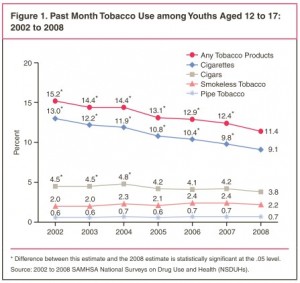 Among adult smokers, more than half had their first cigarette before age 18, and more than half became daily smokers before that age*. Given the substantial lifetime health and economic burden from the use of cigarettes and other tobacco products, preventing and reducing adolescent use of these products continue to be important public health goals. A variety of approaches have been undertaken to address this problem. Schools offer health education programs targeting the use and abuse of licit and illicit substances, including tobacco. Substantial tax increases on tobacco products have been levied at the local, State, and Federal levels. States also have increased their enforcement of the Synar Amendment, which requires States to have laws in place prohibiting the sale and distribution of tobacco products to persons under age 18 and to enforce those laws effectively. In 2008, the national retailer violation rate was 9.9 percent – the lowest rate since the program began in 1996**. Despite these efforts, adolescents continue to use tobacco products. Understanding trends in tobacco product use and the shifting demographics of adolescent users can help to further refine educational and enforcement efforts.
Among adult smokers, more than half had their first cigarette before age 18, and more than half became daily smokers before that age*. Given the substantial lifetime health and economic burden from the use of cigarettes and other tobacco products, preventing and reducing adolescent use of these products continue to be important public health goals. A variety of approaches have been undertaken to address this problem. Schools offer health education programs targeting the use and abuse of licit and illicit substances, including tobacco. Substantial tax increases on tobacco products have been levied at the local, State, and Federal levels. States also have increased their enforcement of the Synar Amendment, which requires States to have laws in place prohibiting the sale and distribution of tobacco products to persons under age 18 and to enforce those laws effectively. In 2008, the national retailer violation rate was 9.9 percent – the lowest rate since the program began in 1996**. Despite these efforts, adolescents continue to use tobacco products. Understanding trends in tobacco product use and the shifting demographics of adolescent users can help to further refine educational and enforcement efforts.
The National Survey on Drug Use and Health Data

Figure 1 (click to enlarge). Difference between this estimate and the 2008 estimate is statistically significant at the .05 level. Source: 2002 to 2008 SAMHSA National Surveys on Drug Use and Health (NSDUHs).
Trends In The Use Of Tobacco Products

Figure 2 (click to enlarge). Difference between this estimate and the 2008 estimate is statistically significant at the .05 level. Source: 2002 to 2008 SAMHSA National Surveys on Drug Use and Health (NSDUHs).
Trends In Cigarette Use, By Gender
Past month cigarette use decreased for both female and male adolescents between 2002 and 2008 (Figure 2). Among females, cigarette use decreased from 13.6 percent in 2002 to 9.2 percent in 2008; among males, it decreased from 12.3 to 9.0 percent, respectively.
Trends In Initiation Of Cigarette Use

Figure 3 (click to enlarge). Source: 2002 to 2008 SAMHSA National Surveys on Drug Use and Health (NSDUHs).
in the 12 months before the survey interview among adolescents who had not previously used them) remained relatively stable at 6.7 percent in 2002 and 6.2 percent in
2008 (Figure 3). Considered by gender, 2008 data showed that 6.7 percent of females who had never smoked previously initiated use in the year before the survey, as did 5.7 percent of their male counterparts. However, these rates did not differ significantly from corresponding rates between 2002 and 2007.
Discussion
The findings in the report present mixed results on trends in adolescent tobacco use. On one hand, the prevalence of past month use of any tobacco products among adolescents has generally declined since 2002. This decline is accounted for by decreases in past month cigarette use—the most frequently used tobacco product. On the other hand, rates of use of other tobacco products generally have remained stable, as have rates of recent initiation of cigarette use. These findings suggest that efforts that encourage adolescents to stop smoking are working, and efforts to reduce cigarette initiation may need to be bolstered. Additionally, these findings suggest that prevention and cessation efforts need to continue to be directed toward use of other tobacco products, such as cigars, smokeless tobacco, and pipe tobacco.
Adapted from NSDUH Report by CFisher
Reference:
Substance Abuse and Mental Health Services Administration, Office of Applied Studies. (October 15, 2009). The NSDUH Report: Trends in Tobacco Use among Adolescents: 2002 to 2008. Rockville, MD.
End Notes
*U.S. Department of Health and Human Services. (2000, November). Healthy People 2010: Understanding and improving health (2nd ed.). Washington, DC: U.S. Government Printing Office. [Available as a PDF at http://www.healthypeople.gov/Publications/]
**Center for Substance Abuse Prevention. (2009). FFY 2008 Annual Synar Reports: Youth tobacco sales. Rockville, MD: Substance Abuse and Mental Health Services Administration. [Available as a PDF at http://prevention.samhsa.gov/tobacco/default.aspx]
No comments yet.